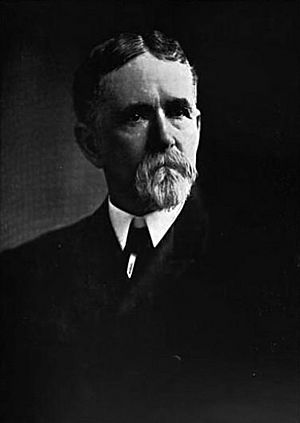John Lamb (congressman) facts for kids
Quick facts for kids
John Lamb
|
|
|---|---|
 |
|
| Member of the U.S. House of Representatives from Virginia's 3rd district |
|
| In office March 4, 1897 – March 3, 1913 |
|
| Preceded by | Tazewell Ellett |
| Succeeded by | Andrew J. Montague |
| Chairman of the Committee on Agriculture | |
| In office March 4, 1911 – March 3, 1913 |
|
| Preceded by | Charles F. Scott |
| Succeeded by | Asbury F. Lever |
| Personal details | |
| Born | June 12, 1840 Sussex County, Virginia |
| Died | November 21, 1924 (aged 84) Richmond, Virginia |
| Resting place | Hollywood Cemetery, Richmond, Virginia |
| Political party | Democratic |
| Profession | farmer, businessman, politician |
| Military service | |
| Allegiance | Confederate States of America |
| Branch/service | Confederate Army |
| Unit | Company D, 3rd Virginia Cavalry |
| Battles/wars | American Civil War |
John Lamb (born June 12, 1840 – died November 21, 1924) was an important person from Virginia. He was a farmer, a businessman, and a politician. He also served as an officer in the Confederate Army during the Civil War. John Lamb was a member of the United States House of Representatives for 16 years.
Contents
Growing Up and Family Life
John Lamb was born in Sussex County, Virginia. His parents were Ann Christian and Lycurgus Lamb. His father was a farmer, a schoolteacher, and a surveyor. John had several sisters and a younger brother named James. James later became a lawyer and a judge.
The Lamb family had a large farm called "Rural Shades" in Charles City County. For many years, families like the Lambs in the South used enslaved people to work on their farms. This was a common practice in that time, but it was a very unfair system. In 1850, John's father owned 15 enslaved people. Ten years later, his mother owned 14 enslaved people.
John's mother's family also came from early settlers in the American colonies. His great-grandfather, Joseph Christian, fought in the American Revolutionary War. John's father taught him at home because there were no public schools yet in Virginia. After his father died, John continued to study civil engineering on his own.
Serving in the Civil War
When the American Civil War began, Virginia decided to leave the Union. John Lamb joined the Confederate Army on May 18, 1861. He was a private in Company D of the 3rd Virginia Cavalry. His unit was sent to western Virginia.
John Lamb was captured by Union soldiers on September 29, 1861. He was later exchanged for a Union prisoner on October 8, 1862. After his unit fought in the Battle of Gettysburg, John became an officer. He was made a lieutenant on September 21, 1863.
He was wounded in battle on April 18, 1864. Soon after, on April 30, 1864, he was promoted to Captain. He was wounded again on May 28, 1864. Captain Lamb led his company for the rest of the war.
Marriage and Children
On November 10, 1869, John Lamb married Martha Redd Wade in Richmond. Her family called her "Mattie." They had a daughter named Bessie and four sons: Anderson, John, William, and Frederick. Most of their children were born at their farm called "Green Yard" in Charles City County. In 1888, the family moved to Richmond, Virginia.
Political Career and Public Service
After the Civil War, John Lamb continued to work on his family's farm for about ten years. In 1869, he ran for a seat in the Virginia House of Delegates but did not win. However, he did win local elections in Charles City County. He served as sheriff, treasurer, and surveyor for the county.
In 1896, John Lamb was elected to the United States House of Representatives as a Democrat. He won re-election seven more times. This meant he served in Congress for 16 years, from March 4, 1897, to March 3, 1913. During his time in Congress, he was the chairman of the Committee on Agriculture. In 1912, he lost his re-election bid to former Virginia governor Andrew Jackson Montague.
After leaving Congress, John Lamb stayed in Richmond. He became the superintendent of the Virginia Historical Society. This society has many important historical items, including murals about the Confederacy.
Later Life and Legacy
John Lamb's wife passed away before him. He died in Richmond on November 21, 1924. He was buried in the historic Hollywood Cemetery in Richmond. Many of his family members are also buried there.
Images for kids


